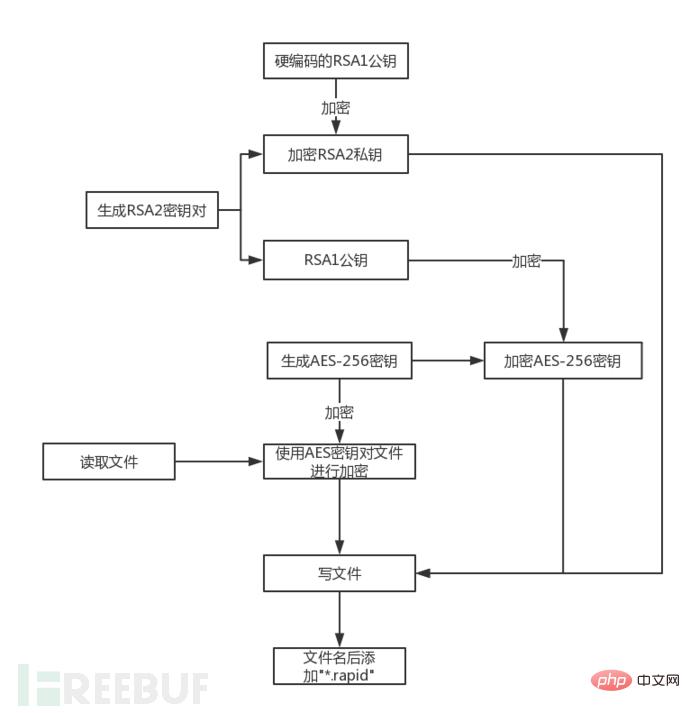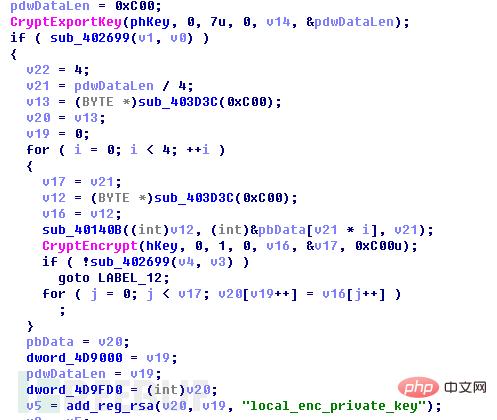勒索病毒一直是安全行业的一个热点,近期安全人员发现了一款名为rapid的勒索病毒,该勒索病毒使用了 rsa加aes对文件进行加密,它不仅会感染计算机上已有的文件,还会对新创建的文件进行加密。本文对rapid病毒进行了详细分析,剖析其加密机制,解析其加密后的文件。
当rapid病毒运行时,它会创建多个线程不断扫描文件系统,进行文件加密,它不仅会感染计算机上的已有文件,还会对新创建的文件进行加密。被加密的文件,其文件名被添加“.rapid”扩展名,同时文件大小增加了0x4D0字节。

rapid病毒将在进行加密的文件夹中创建名为“How Recovery Files.txt”的勒索提示文件,文件中包含一个电子邮件,让受害者联系如何完成付款。用户重启电脑,将自动弹出名为“recovery.txt”的勒索提示文件,其内容和“How Recovery Files.txt”文件内容相同。

使用兰眼(LanyEye)下一代威胁感知系统对rapid程序进行检测。在兰眼中,rapid程序被标记为高危:

接下来对rapid程序进行逆向分析。
首先程序调用ShellExecuteA执行如图所示命令:

主要作用包括清除Windows卷影拷贝,防止受害者使用卷影拷贝恢复文件。禁用系统修复和自动修改功能,勒索程序可能加密驱动文件导致系统频繁崩溃,禁用修复功能,忽略错误降低系统崩溃概率。终止oracle.exe、sqlite.exe、sql.exe进程,一方面,可以释放内存,另一方面,可以解除这些数据库进程对某些文件的占用。
接着程序添加开机启动项,在注册表HKEY_CURRENT_USER\Software\Microsoft\Windows\CurrentVersion\Run下新建Encrypter和userinfo项,Encrypter项值为“%AppData\Romaing\info.exe”,userinfo的项值为“%AppData\Romaing\recovery.txt”。“info.exe”文件是勒索病毒程序自身的拷贝,“recovery.txt”文件是勒索信息文件,文件内容和上文提到的“How Recovery Files.txt”文件内容相同。


本次为了保证系统能够正常运行,程序不会选取文件夹名称为“Windows”、“intel”、“nvidia”、“ProgramData”和“temp”下的文件:

此勒索软件并没有通过后缀名过滤文件而是判断选取的文件是不是“How Recovery Files.txt”、“info.exe”、“recovery.txt”,如果是其中三个文件则跳过,剩下的全加密。


程序首先创建了一个PROV_RSA_FULL类型的CSP容器,然后将通过Base64的硬编码在程序中的RSA的公钥(命名为RSA1)导入。

接着程序会查看是否存在注册表项“local_public_key”。如果没有则会创建注册表项“local_public_key”

程序创建了一个PROV_RSA_FULL类型的CSP容器,并且调用CryptGenKey()生成了随机RSA密钥对(命名为RSA2)。

之后调用CryptExportKey()导出刚刚生成的RSA2私钥数据,并调用RSA1公钥对RSA2私钥加密。加密完成后,将RSA私钥数据写入注册表项HKEY_CURRENT_USER\Software\EncryptKeys\local_enc_private_key,将数据长度写入注册表项HKEY_CURRENT_USER\Software\EncryptKeys\local_enc_private_key_len

再次调用CryptExportKey()导出刚刚生成的随机RSA2公钥数据,这次不需要加密,直接写入注册表HKEY_CURRENT_USER\Software\EncryptKeys\local_public_key和HKEY_CURRENT_USER\Software\EncryptKeys\local_public_key_len。

之后开始对文件进行加密,获取选取文件的大小,如果文件大小小于0x4D0字节,则直接进入加密流程;否则读取文件尾部0x20字节的数据,并判断这部分数据是不是加密标志“F5 D5 CD CD CD 7D CD CD 95 91 C1 C1 CD AD CD CD 41 CD 41 CD C1 99 FD 1D 59 95 81 FD 99 79 25 A5”,如果不是则进入加密流程,否则选取下一个文件。因为加密过的文件是大于0x4D0的,并且在其文件尾部添加了0x20个字节的加密标志

程序进入加密流程后,会先调用CryptGenKey()生成随机AES密钥。

并调用CryptExportKey()导出AES密钥数据,BLOBTYPE=PLAINTEXTKEYBLOB:

如图所示返回数据长度0x2C,0x3A42A8-0x3A42AF是BLOBHEADER ,0x3A42B0-0x3A42B3是keysize,0x3A42B4-0x3A42D3是AES的密钥,0x3A42D4-0x3A4327则是使用0xCD填充的数据:

使用RSA2公钥加密AES密钥,加密的是上文中提到的“BLOB格式数据+AES密钥+填充数据”这整个0x80字节的数据:

读取文件数据,使用AES密钥对读取的文件数据进行加密 :

AES加密是按照128bit进行分组,当原文件字节数不是128bit的整数倍时,加密后的密文数据将会大于明文数据,所以程序在加密前在明文尾部填充了0x10个字节的0x00(一个AES分组的字节数)。
向文件覆写加密后的数据,首先只写入原文件大小的密文数据,变多的0x10字节的数据接下来再写;
继续向文件中写数据,写入0x4D0字节的数据。这0x4D0字节的数据包括五部分:第一部分0x10字节,这部分就是变多的数据;第二部分0x20字节,包含源文件文件大小的字符串和0xCD的填充数据;第三部分0x80字节,是被加密的AES密钥数据;第四部分0x400字节,是被加密的RSA2私钥数据;第五部分0x20字节,是文件加密标志数据。

在文件名后添加“.rapid”扩展名:

显示勒索信息

至此,我们已经分析完了rapid勒索软件的文件加密流程,接下来我们来分析被加密后的文件。
假设一个大小为0x9000字节的文件被rapid程序加密,加密后的文件结构如下:

rapid勒索病毒使用数字签名(RSA_AES-256)对文件进行加密,文件解密需要获取数字签名的私钥。但是,数组签名的私钥使用RSA加密,在没有RSA私钥的情况下,很难获取数字签名的私钥,文件恢复的难度极大。
2017年是勒索病毒高发的一年,可以预见2018年这种状态仍将持续,我们每一个人都应该提高警惕,切勿打开来自可疑邮箱的附件,避免使用第三方软件资源,安装防病毒软件,降低安全隐患。
以上就是如何进行Rapid勒索病毒分析与检测的详细内容,更多请关注php中文网其它相关文章!

每个人都需要一台速度更快、更稳定的 PC。随着时间的推移,垃圾文件、旧注册表数据和不必要的后台进程会占用资源并降低性能。幸运的是,许多工具可以让 Windows 保持平稳运行。

Copyright 2014-2025 //m.sbmmt.com/ All Rights Reserved | php.cn | 湘ICP备2023035733号